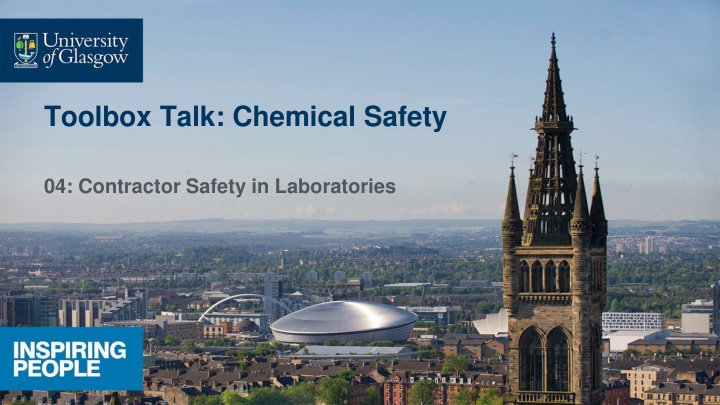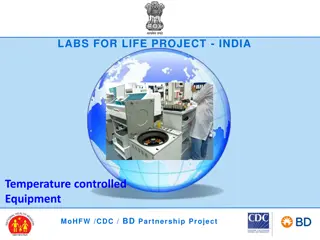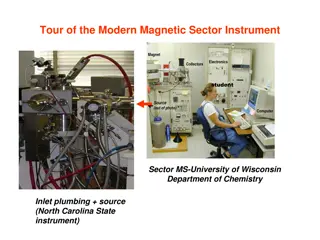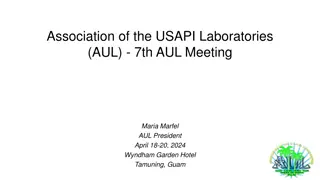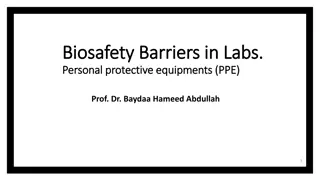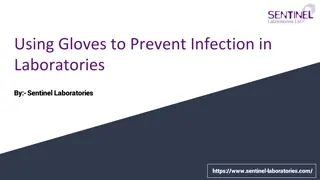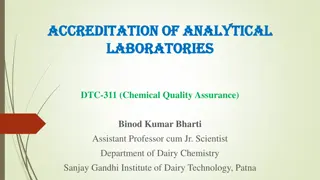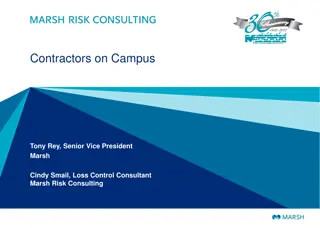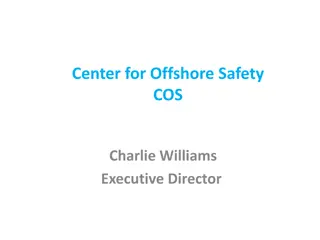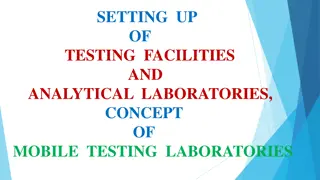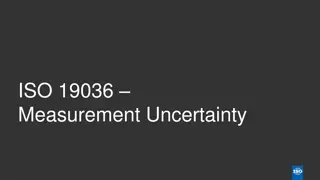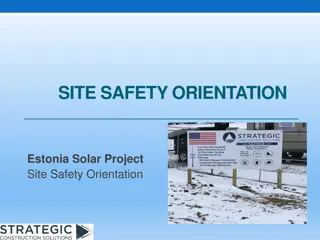Contractor Safety in University Laboratories: Best Practices
Enhance safety for contractors working in university laboratories by familiarizing them with potential hazards, safety protocols, emergency procedures, and the importance of following guidelines provided by laboratory staff. The presentation covers various types of laboratories, common hazards, safety rules, and key steps to ensure a safe working environment, emphasizing the need for caution and awareness in laboratory settings.
Download Presentation

Please find below an Image/Link to download the presentation.
The content on the website is provided AS IS for your information and personal use only. It may not be sold, licensed, or shared on other websites without obtaining consent from the author.If you encounter any issues during the download, it is possible that the publisher has removed the file from their server.
You are allowed to download the files provided on this website for personal or commercial use, subject to the condition that they are used lawfully. All files are the property of their respective owners.
The content on the website is provided AS IS for your information and personal use only. It may not be sold, licensed, or shared on other websites without obtaining consent from the author.
E N D
Presentation Transcript
Toolbox Talk: Chemical Safety 04: Contractor Safety in Laboratories
Introduction This presentation is designed to help contractors working in University buildings work safely and covers the following: Confirming that an area has been cleared and is safe to enter Identification of the possible risks in a working area Safety checklist to be completed before starting work Simple safety rules to reduce the risk of exposure to hazardous substances Ensuring good hygiene when working in laboratories Knowing what to do in the event of an emergency Emergency contacts
Types of Laboratory University buildings may contain a variety of laboratories: Teaching laboratories Chemical research laboratories Biological containment laboratories Radiation laboratories Chemical / solvent stores Compressed gas storage cages Cryogenic storage Other specialist laboratories or storage areas (e.g. NMR laboratories) Remember that not all hazards in the laboratory will be immediately obvious to the naked eye!
Sample Laboratory Hazards Toxic, corrosive or harmful chemicals Biological agents Radioactive substances Sharps (glass, needles etc.) Compressed gas cylinders Cryogenic materials Hot surfaces Electrical equipment Slips, trips, falls etc.
Before Starting Work in a Laboratory Identify local contact / responsible person for the laboratory Confirm that the working area has been cleared Familiarise yourself with any hazards in the area Ensure you are familiar with warning signals, alarms etc. Identify areas that are off-limits (and respect these) Make sure isolations have been carried out (permit system) Locate first aid kits and emergency exits Ensure you know what to do in an emergency!
Simple Safety Rules for Contractors No unauthorised entry to laboratory areas Wear the correct PPE as directed by laboratory staff Follow all instructions from laboratory staff Work safely, stored materials, tools, trailing power cables Only approved power sockets should be used for tools etc. Don t touch anything other than what you are working on Don t unplug or switch anything off without permission Isolations (permit to work) If you see something untoward, tell someone! If something is leaking, broken or spilled, tell someone!
Laboratory Hygiene Rules Do not eat or drink in any laboratory Do not take food, drink, cigarettes etc. into a laboratory Smoking is not permitted in any university buildings Never put anything in your mouth (e.g. pencils, fingers etc.) Cover all cuts or wounds with a waterproof dressing Do not place personal items (e.g. phones, keys etc.) on any work surfaces in laboratory or storage areas. Do not touch any chemical containers, spillages or equipment Always wash your hands before leaving the laboratory, smoking, eating or going to the lavatory.
What to do in an Emergency Immediately report any accidents, spills, leaks or breakages Evacuate the laboratory calmly and do not re-enter until told to do so DO NOT attempt to clean up after a spillage or leak of any chemical DO NOT pick up broken glass with your fingers If you come into contact with ANY chemical wash the area with cold water for 15min Inform the local safety coordinator of ALL incidents In the event of a fire actuate the nearest alarm call point and evacuate the building Contractor Assembly Point?
Fire Safety Considerations Do you know the Fire Safety Procedures for the Joseph Black Building? Where can I get this information? Does my planned work have any effect on the building fire safety procedures? Who do I speak to regarding this? Does my work require a permit? (i.e. hot works or Fire Alarm Isolation) How do I get a permit for this? What do I do if I discover a fire? What are the consequences if I set of the fire alarm during class time? What should I do if the fire alarm activates whilst I am in the building?
Isolation Permit System Before carrying out any work involving isolation / disablement of a heat / smoke detector head a permit must be obtained. Permits will only be issued following receipt of a correctly completed of a permit request. At the conclusion of works the detector head must be reinstated before leaving the area. Once the detector has been reinstated, the building manager should be informed immediately and the isolation permit formally cancelled. Isolations should last for the minimum period practical and where possible all detector heads should be reinstated by the end of the working day (5pm).
Contact Information Local Emergency Contacts (INSERT BUILDING NAME) Contact 1 Contact 2 Contact 1 Photo 0141 330 XXXX 0141 330 XXXX Emergency / Fire / Ambulance Campus Security 0141 330 4444 Contact 2 Photo In the event of an emergency you should call 4444 from an internal phone to inform security who will dial 999 and direct the emergency service to your location.
For Further Information Contact: Dr. Phil Rodger (Chemical Safety Adviser) E: Philip.Rodger@glasgow.ac.uk T: 0141 3302799
